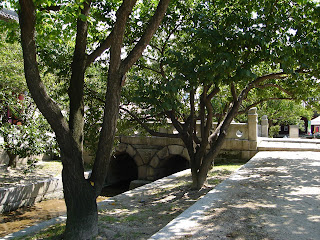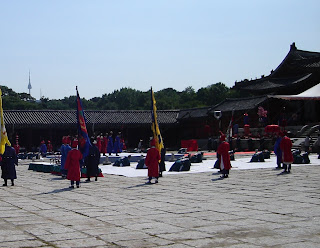As promised, here is the continuation of my adventures from this weekend...
Saturday was our monthly branch temple trip, so of course I went to the temple and had a wonderful time there with friends from church. Since I was in Seoul anyway, I decided to go do some more sightseeing while I was there. I decided to go see another palace that I had on my list of to see places... Changgyeonggung, the Palace of Flourishing Gladness.
So as is my habit here, I found out the route to take on the subway to get there and headed out. My information said to get off at the Hyehwa stop, go out exit #4 and take a 10 minute walk to the palace. So I got off the train, went out the appropriate exit and looked around for a sign or something to direct me to the palace. There was none. So I started walking in the diection I thought it would be. After walking a bit I looked off to the left and saw this:

So of course I thought, "This must be the palace I've been looking for." Imagine my surprise when I found out that it was not, but was instead a place called Hyehwamun, the little east gate.

It was built in 1396 as one of the four minor gates in the Seoul city wall. It was a busy passageway into the city since Sukjeonmun, the north gate, was closed most of the time. I spent a few minutes just looking around the gate and was excited about the discovery I had made just by exploring. It made me think of my sweet wife and all the adventures she has by exploring. I hope she is proud of me.
So I went back to the subway and found a map near the turnstiles and found out where the palace actually was. Of course I had originally gone the exact opposite way. But after finding out where it was I was off again.

As I do with all the palaces, I took a picture of the main gate and then headed into the palace proper. This palace was built in the early 15th century by Great King Sejong for his parents.



Entering all the royal palaces you find waterways and stone bridges crossing them. The streams are seen as divine water that carries the spirit of nature. Crossing the bridge over the stream is supposed to protect people from evil spirits. The two rainbow shaped arches are a classic design of these bridges. The bridge is the oldest surviving structure within the palace area, dating from the 15th century.

I went in to the courtyard area of the main hall, but that was as close as I could get to it. There were camera crews and setups all over the place. I assumed they must be having some sort of ceremony there later. Lucky me... I had seen the changing of the guard the day before and now I would get to see another ritual.
I walked around the different areas of the palace taking lots of pictures of the different halls and structures and admiring the great architecture. I am so amazed by the technology that existed in ancient Joseon.











As I said before, there was a huge setup going on near the main hall and as Iwas headed toward the main part of the palace I heard drum beats starting to sound. I knew that the ceremony, whatever kind it was, was beginning. So I hurried up my steps and got to the main hall not too long after it had started.
What I got to see was great. It was called Eoyeonrye and it is a ceremony in which the king offered a banquet to his retainers as a reward for their loyalty and offerings to him. In the ceremony that was presented there was 1. the entrance of the honor guard and musicians (which I missed), 2. the positioning of the retainers (this was done using the stones along the walkway to the palace... I mentioned that in yesterday's post too), 3. the appearance/entrance of the king, 4. the entrance of the crown prince and his retainers, 5. vow and obeisance to the king by prince and retainers, 6. offering of gifts and wine to the king, 7. votive offering to the retainers, and 8. music and dance by royal court performers.










No comments:
Post a Comment